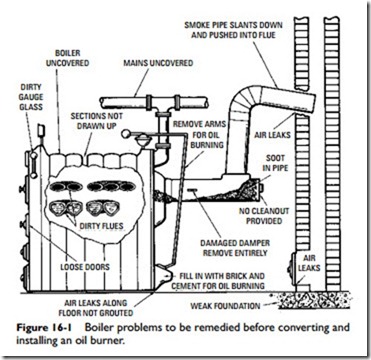Sometimes it becomes necessary to convert an existing boiler or furnace to another fuel. This is usually the case when the fuel for which it was originally designed has become too expensive relative to others or does not meet the desired level of efficiency. During the early 1950s, when coal was becoming more and more expensive as a domestic heating fuel and before oil and gas burners were offered as integral parts of heating units by manufacturers, converting boilers and furnaces was a much more widespread practice than it is today.
A number of manufacturers have made available gas-fired and oil- fired burners specifically designed for boiler and furnace conversions. It would be impossible within the space limitations of this chapter to cover all the different models of conversion burners offered by these manufacturers. Consequently, this chapter will emphasize all the ramifications involved in converting a boiler or furnace from one fuel to another instead of examining the specifications and operating characteristics of one or more conversion burners.
Initially, most coal burning furnaces and boilers were converted to oil or gas. This was done not only for convenience (the coal- burning appliances required more hands-on maintenance) but also for heating efficiency and lower energy costs. Tighter environmental regulations covering oil storage tanks (the tanks would often develop leaks as they became older) and the sudden rise in heating oil costs as the result of the 1970s oil crisis motivated a widespread conversion from oil to gas.
Before deciding to convert from one fuel to another, consult with a technician from a reputable heating dealer about the ramifications, practicality, and safety factors involved in converting. You may be able to lower energy costs by increasing the insulation levels in the home and by replacing the furnace or boiler with a high- efficiency appliance burning the same fuel. That is, better results might be obtainable by upgrading the system instead of converting.
If there is no alternative to converting from one fuel to another, then operating safety must be a primary consideration, followed by heating efficiency and energy costs. There are some potential safety hazards involved in converting from an oil-fired furnace or boiler to a gas-fired one. If the technician making the conversion is knowledgeable about these hazards, then proper precautionary measures can be taken to ensure safe operation. When using gas burners in a converted oil heating system, consider the following:
• Gas burners require greater amounts of excess combustion air than an oil burner does to ensure safe operation. Lower amounts can lead to the production of odorless, colorless, and deadly carbon monoxide gas. ALWAYS install a carbon monoxide gas detector near a gas combustion burner.
• Gas burners produce much more water vapor than oil burners.
These water vapors will condense on the walls of the chimney and flue as they cool. This condensed water is acidic and can damage the chimney mortar, flue surfaces, and even the heating appliance itself. Consequently, some state and local codes have mandated the upgrading or replacement of the chimney and flue along with the installation of a gas-conversion burner. Upgrading the chimney involves lining it with an acid-resistant material. It is often necessary to install a new vent system meeting the requirements of gas-burner combustion.
• The gas burner flame pattern must match the size and shape of the combustion chamber, which was originally designed for an oil burner flame. The two kinds of flame have different sizes and characteristics. If this is not taken into consideration when the gas conversion burner is installed, the gas flame may contact the internal surfaces of the combustion chamber, resulting in the production of carbon monoxide gas.
Note
ALWAYS measure the carbon monoxide emission of a gas conversion burner immediately after it is installed. According to the ANSI Standard, CO emissions must be below 0.03 of the exhaust gases.
Preparation for Conversion
Before constructing a combustion chamber and installing a burner, the heating system should be carefully checked for defects and cleanliness. A boiler or furnace in need of repairs will not give satisfactory results after the burner is installed. Be certain that all flue passages are cleaned so that the maximum amount of heat generated is absorbed by the boiler. Soot and ash are good insulators, and both are always undesirable.
All doors should fit tightly, and all other openings or cracks should be tightly cemented shut. The stack from the furnace to the chimney should have tight joints. Dampers should not close off ore that 80 percent of the cross-sectional area of the stack. Stacks should be inspected for leaks and obstructions of any kind.
Remove the old fuel-handling parts (e.g., the coal-handling parts in a coal-fired furnace or boiler) and thoroughly clean the interior surfaces, removing all soot, scale, tars, and dirt.
Any cracks in the heat exchanger should be repaired or replaced. On boilers, any water leaks should be sealed, broken gauges replaced, and loose boiler doors repaired or replaced. Air leaks along the floor should be grouted.
No positive catches should be used on firing doors. File off any catches so that the firing door will open easily to relieve pressure. A spring-loaded door holder is recommended.
If a conversion burner with a direct spark ignition system is installed, no provision need be made for top venting or horizontal or downdraft furnace. Check the local codes for further information.
Figure 16-1 illustrates some of the typical problems encountered when converting a coal-fired boiler to oil. It is highly doubtful that
a boiler would have all these problems at the same time, but for your convenience they are included in the illustration to serve as a reference.
